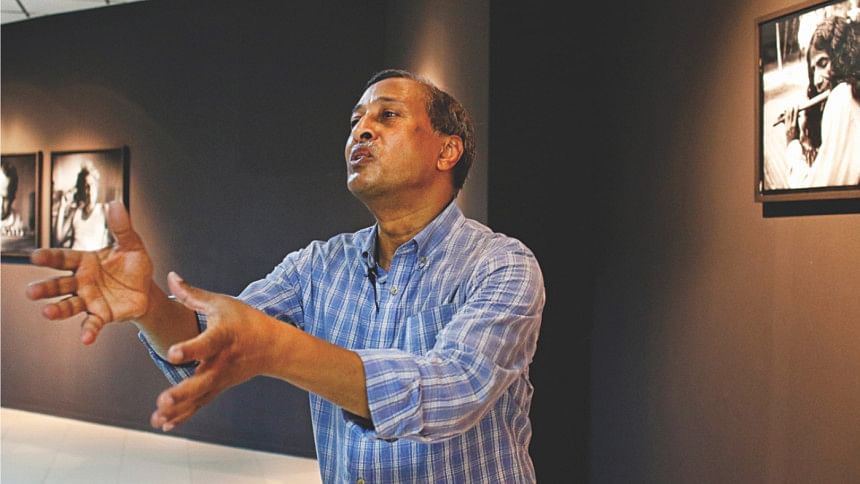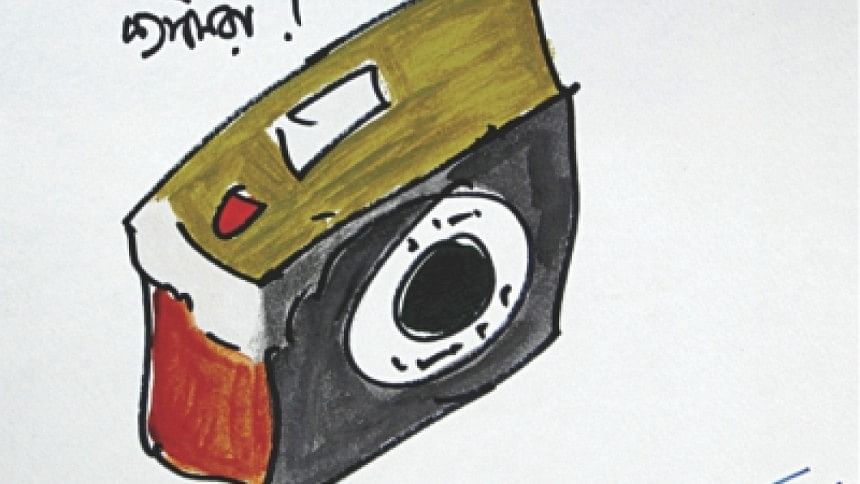Poetry in Frames

Photos: Nasir Ali Mamun
In the world of visual arts, Nasir Ali Mamun needs no introduction. For more than five decades, his iconic photographs have inspired many a young artiste. Best known for his portraits of internationally recognised celebrities, Mamun is considered to be the first person to popularise portrait-photography in the country. Over the years, his work has been exhibited in several galleries and also been published -- 55 solo exhibitions and 10 books. This year, at the ninth edition of Chobi Mela, Nasir Ali Mamun, along side prodigious photographer Sayeeda Khanam were awarded with the Lifetime Achievement Awards. This year, Mamun's creations and the stories behind them have been exhibited at this year's Chobi Mela.
Nasir Ali Mamun remembers the year 1966, when 'portrait' was a term only used in newspapers or tabloids. “When I was a child, I used to see photographs of famous people in newspapers and they used to make me think about the stories behind the creations,” says Mamun. He first held a camera when his brother and he borrowed an A1 camera from a nearby studio, planning to take some pictures near Dhanmondi Lake. “I remember taking a portrait of my brother -- the first portrait I ever took. The first time I clicked, I felt like the world was my oyster.” For young Mamun, the camera was still a curiosity rather than a profession— until the 70s.

“It was a burning time— high oil prices and food crisis," remembers Nasir Ali Mamun. "In 1969, man landed on the moon and astronauts took portraits of earth. It was an exciting yet unsettling time for human civilization! Around then, I decided to go into a new frontier and take portrait photography as a profession,” says Mamun.
The first professional portraits Mamun took were of poet Ahsan Habib, poet and writer ANM Bazlul Rashid and communist leader Comrade Moni Singh -- all taken on the same day. “I first went to every famous person I could find—not to take their pictures but to make a list of eminent people. Figures from Samsur Rahman to Professor Abdur Razzaq, contributed to this list of mine.”
Chobi Mela IX featured some his earliest works which included legendary figures such as Bangabandhu Sheikh Mujibur Rahman, ASM Abdur Rob, Ahsan Habib, Shamsur Rahman, Syed Shamsul Haq, Al Mahmud, Ustad Gul Mohammad, Professor Mohammad Yunus, Samar Das, Hamidur Rahman, Khan Mohammad Moinuddin, Golam Mustafa, Suborna Mustafa, Abdul Hafiz, Mahmuda Khatun Siddiqua and others. The gallery filled with Mamun's work was named 'The Poet with Camera'.

Mamun's portraits have always been poignant. “My portraits may reflect some obscurity, because most of the famous people I have worked with have a sad side to their lives.” Mamun's portraits of eminent artist S M Sultan can be a perfect example of his style.
“I first met Sultan around 1977 in his house at Norail," he remembers. "The first thought that popped into my head after meeting him was that he himself was a master artwork; the way he talked, the way he walked, everything had an artistic touch! His house was filled with animals from snakes to cats and I remember I had to share a room with some of his animals!” Mamun was one of the lucky few who had the opportunity to see Sultan up close and personal. “The man was a saint. From animals to humans, everyone considered him to be a person above mere beings. All that being said, Sultan was a lonely person. He had no family other than his pets and students. This loneliness reflected in the photos I took of him—as his smile spoke of all his sorrows.”

The same emotion was bestowed upon Dr Muhammad Yunus's portrait as well. Mamun met Yunus in 1985 when he was teaching at Chittagong University and had just come up with the concept of Grameen Bank. “I needed funds for an exhibition for which a friend of mine suggested I meet with this professor at Chittagong who had his own bank. That was the first time I met Dr Yunus.” The photo which was showcased at the exhibition of the Nobel Laureate portrays a young Yunus, at the Chittagong University quarters. “His face reflected of his ambition but also had a hint of melancholia. Yunus sir, even when I first met him was very cordial and used to smile at everything. There was a swing in his house, which seemed lonely to me. When the picture came out my eyes directly went to his face and I could see that emotion, and I think now the viewers can see it too.”
Mamun's entire life was dedicated to searching for these icons and capturing their unique essence with his camera. “Most of the people I embarked on were so humble to begin with that they didn't actually realise that they were celebrities. I sometimes had to remind them and even told them that they would be famous if I took a picture of them!” says Nasir Ali Mamun. This journey however wasn't always a smooth walk. “There were times when I actually annoyed some of these people. One of who was annoyed the most was the mother of peace herself, Mother Teresa.”

Mamun approached Mother Teresa for a picture when she was in the car set to go to a function, when she visited Dhaka on January, 1981. “I told her it would take two minutes and though her associates were ready to kick me out, she with much irritation said yes. I remember she told me and I quote, "Do you know how many children are waiting for me now and they have to wait more just for you? How does that make you feel?" After hearing this I was filled with guilt.” The picture of Mother Teresa displayed at the Chobi Mela portrayed a very gloomy, somewhat angry Teresa. “You would see that her eyes were popping out with anger and her face easily reflected her rage. Clearly, it was because of this annoying photographer and not world poverty!"


Chobi Mela also exhibited many historical collections of Mamun such as Sultan's sketch of Mamun, Dr Yunus's drawing of Mamun's camera, autographs of personalities such as Selina Hossain, Bhupen Hajarik, Mamun with his first camera, his first solo exhibit at Bangla Academy, etc. “There were some moments when I knew that I had to be a part of a photograph. One of these moments happened when I was with Samsur Rahman and Ustad Bahadur Hossain Khan.” Mamun's plan was to capture Bahdur Hoassain Khan but when he brought out his Sarod and Samsur Rahman was sitting right beside him, suddenly it was a different story altogether. “The lighting, the ambience of the room somewhat called me to sit beside them. So I put the camera on a timer and slowly sat down beside them in such a way that they didn't notice me at all.” Mamun was lucky enough to document poet Samsur Rahman until he died. The image of Samsur Rahman shaving his beard portrays a different layer to the personality of this grand poet. “He actually asked me to not showcase this picture but it came out so good that I just had to!” Nasir Ali Mamun is now regarded as the poet of the camera. This tag was first given to him by Samsur Rahman when Mamun asked him for an autograph.
Mamun's photographs have stories to tell. His camera portrays a completely different aspect of a personality that cannot be seen otherwise with the naked eye. Over the years, Nasir Ali Mamun has demonstrated how he wrote poetry through frames and this exhibition gave an astonishing glimpse of his verses.

 For all latest news, follow The Daily Star's Google News channel.
For all latest news, follow The Daily Star's Google News channel. 



Comments